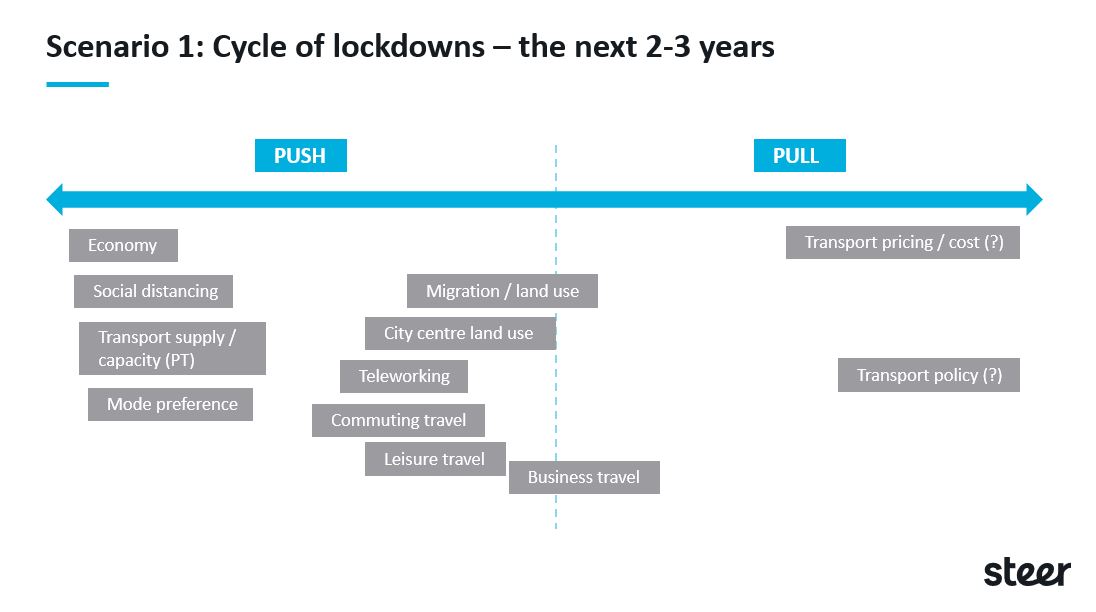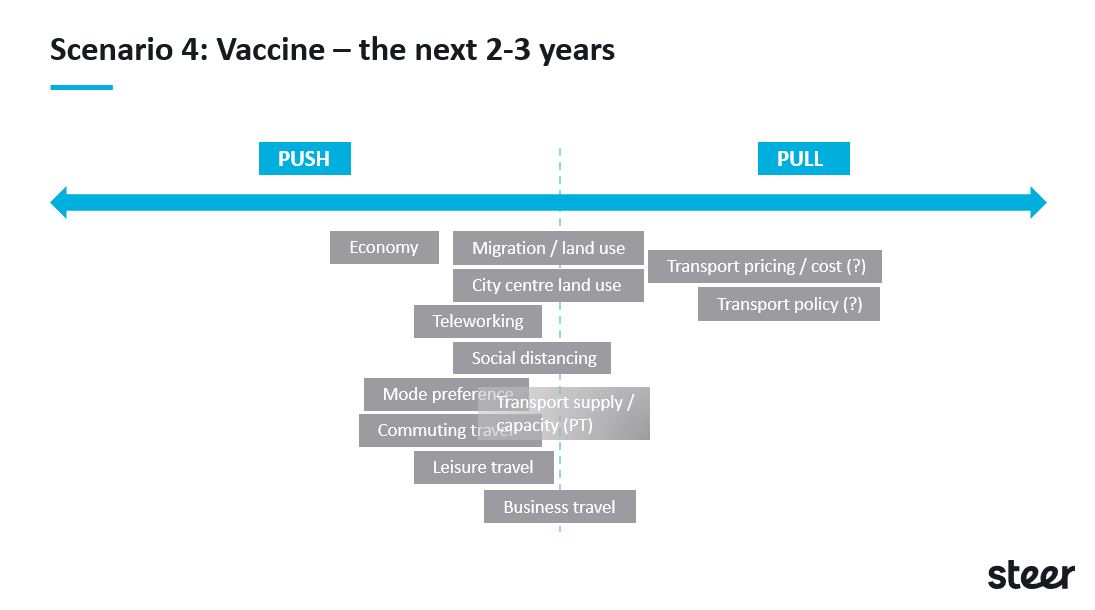Previously we set out four medically-driven scenarios that help us think about what the economy, people’s activity and transport demand may look like in 2-3 years in a post-COVID-19 world:
- Scenario 1 | Cycles of Lockdown: Social distancing and ‘track-and-trace’ fail to stop a second wave of COVID-19. Further lockdowns are necessary over the next 2-3 years with the consequent negative effects on society.
- Scenario 2 | Adaptation: No second wave materialises, and society adapts, finding a new equilibrium of behaviours and activities that keep COVID-19 under control.
- Scenario 3 | Therapeutics: By 2021 an effective clinical pathway is found that significantly reduces health impacts and the mortality rate. Society returns mostly to normal.
- Scenario 4 | Vaccine: An effective vaccine is widely deployed in 2022. Society rapidly returns to pre-COVID-19 norms.
Adapting the UK’s Government Office for Science Futures Toolkit, we first identified 92 potential drivers of change with 12 of these being identified as most important. Thinking about these 12 drivers in each scenario allows us to map out potential futures for different modes of transport in different settings. Today, we consider bus services in England.
From April 2018 to March 2019, 4.32 billion journeys were made by bus, of which 2.20 billion journeys were made in London where buses are regulated, and the remainder in the deregulated market elsewhere in the country. In 2018/19, 38% of bus operators’ revenue came from the public purse.
One week after lockdown was announced, bus use outside London was just 11% of its pre-lockdown norm. As lockdown is relaxed, social distancing means the capacity of buses has been reduced by 75%. By 22 June, bus use outside London was up to 23% of its pre-COVID norm. At the moment, the ongoing operation of the network is dependent on public funding. So, what happens next?
In the two charts below, we have mapped our 12 scenario drivers to be either ‘pull’ factors - things that encourage the use of bus – or ‘push’ factors, those things that will act to discourage bus use.


In our "Cycles of Lockdown" scenario, we face a long and deep recession. Already, the food and beverage and other leisure and retail sectors have been severely affected by lockdown and they face a long and slow recovery. Younger people and women are over-represented in these sectors’ workforces, as they are in the bus market. On-going social distancing will reduce the demand for travel and bus travel will be less attractive, particularly to those most vulnerable should they be infected by the disease. Retirees who contribute about a fifth of bus demand fall into this group.
Changes to activity patterns will all act against bus use returning to pre-COVID levels. Reduced demand will lead to a smaller network and lower frequencies, which will make bus less attractive. Only transport pricing and transport policy have the potential to act as 'pull' factors.
The push/pull factors are the same in our "Vaccine" scenario, but less extreme. In this scenario, the availability of a vaccine means that in theory, we can all go back to our pre-COVID travel behaviours, although in practice the economic downturn will push people away from bus (while much less so than in "Cycles of Lockdown") and changing habits such as greater working from home will also reduce bus demand. Again, only transport pricing and transport policy have the potential to act as pull factors.
Our Scenario 1 ‘Cycles of Lockdown’ and Scenario 4 ‘Vaccine’ represent what we think are extreme yet plausible, worst and best case outcomes. If we don’t like the outcomes that are suggested, how can we intervene to change those outcomes?
At the time of writing, England is sitting somewhere between our Scenario 1 and 2. There is a track and trace system in place, but it is not yet fully effective and Leicester has just entered local lockdown. What the last few months have told us is that circumstances can change quickly, although, even in our best-case scenario, it is hard to see bus use returning to pre-COVID levels, unless there is a radical shift in public policy.
No doubt public sector financial support will keep bus services running for the time being, but sooner or later we’re going to have to address the questions of what is the future for bus and what will be the public and private sectors’ roles in delivering it. Now is the time to start that debate.
